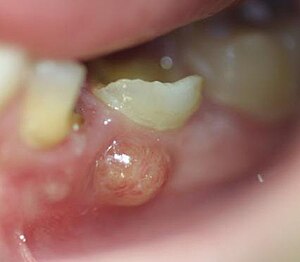Dental abscess
| Dental abscess | |
|---|---|
 |
|
| A decayed and broken down tooth, which has undergone pulpal necrosis (death of the tooth pulp). A periapical abscess (i.e. around the apex of the tooth root) has then formed and pus is draining into the mouth via an intraoral sinus (colloquially termed a gumboil). | |
| Classification and external resources | |
| Specialty | dentistry |
| ICD-10 | K04.6, K04.7 |
| ICD-9-CM | 522.5, 522.7 |
| MeSH | D010482 D005491, D010482 |
A dental abscess (also termed a dentoalveolar abscess, tooth abscess or root abscess), is a localized collection of pus associated with a tooth. The most common type of dental abscess is a periapical abscess, and the second most common is a periodontal abscess. In a periapical abscess, usually the origin is a bacterial infection that has accumulated in the soft, often dead, pulp of the tooth. This can be caused by tooth decay, broken teeth or extensive periodontal disease (or combinations of these factors). A failed root canal treatment may also create a similar abscess.
A dental abscess is a type of odontogenic infection, although commonly the latter term is applied to an infection which has spread outside the local region around the causative tooth.
The main types of dental abscess are:
The pain is continuous and may be described as extreme, growing, sharp, shooting, or throbbing. Putting pressure or warmth on the tooth may induce extreme pain. The area may be sensitive to touch and possibly swollen as well. This swelling may be present at either the base of the tooth, the gum, and/or the cheek, and sometimes can be reduced by applying ice packs.
An acute abscess may be painless but still have a swelling present on the gum. It is important to get anything that presents like this checked by a dental professional as it may become chronic later.
In some cases, a tooth abscess may perforate bone and start draining into the surrounding tissues creating local facial swelling. In some cases, the lymph glands in the neck will become swollen and tender in response to the infection. It may even feel like a migraine as the pain can transfer from the infected area. The pain does not normally transfer across the face, only upwards or downwards as the nerves that serve each side of the face are separate.
Severe aching and discomfort on the side of the face where the tooth is infected is also fairly common, with the tooth itself becoming unbearable to touch due to extreme amounts of pain.
A periodontal abscess may be difficult to distinguish from a periapical abscess. Indeed, sometimes they can occur together. Since the management of a periodontal abscess is different from that of a periapical abscess, this differentiation is important to make.
...
Wikipedia
